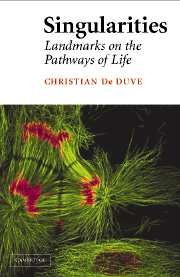Book contents
- Frontmatter
- Contents
- Foreword
- On Christian de Duve: An Editor's Appreciation
- General Introduction
- 1 Building Blocks
- 2 Homochirality
- 3 Protometabolism
- 4 ATP
- 5 Electrons and Protons
- 6 Thioesters
- 7 RNA
- 8 Proteins
- 9 DNA
- 10 Membranes
- 11 Protonmotive Force
- 12 Protometabolism Revisited
- 13 The LUCA
- 14 The First Fork
- 15 Eukaryotes
- 16 Oxygen
- 17 Endosymbionts
- 18 Multicellulars
- 19 Homo
- 20 Evolution
- Final Comments
- Bibliography
- Index
4 - ATP
Published online by Cambridge University Press: 18 January 2010
- Frontmatter
- Contents
- Foreword
- On Christian de Duve: An Editor's Appreciation
- General Introduction
- 1 Building Blocks
- 2 Homochirality
- 3 Protometabolism
- 4 ATP
- 5 Electrons and Protons
- 6 Thioesters
- 7 RNA
- 8 Proteins
- 9 DNA
- 10 Membranes
- 11 Protonmotive Force
- 12 Protometabolism Revisited
- 13 The LUCA
- 14 The First Fork
- 15 Eukaryotes
- 16 Oxygen
- 17 Endosymbionts
- 18 Multicellulars
- 19 Homo
- 20 Evolution
- Final Comments
- Bibliography
- Index
Summary
Throughout the living world, energy circulates almost entirely in the form of a single chemical currency, known as ATP in biochemical jargon. The central function of this substance stands out as one of the most remarkable singularities in the organization of life, all the more impressive because ATP, together with its close relatives and occasional substitutes, GTP, CTP, and UTP, also represents one of the four universal precursors in the construction of RNA, most likely the first information-bearing molecule in the development of life.
Anatomy of a Molecule
ATP stands for adenosine triphosphate. As we shall see in greater detail later, adenosine (A) belongs to the group of nucleosides; it is a combination of the purine base adenine with the five-carbon sugar ribose.
Attachment of a phosphate molecule to the ribose end of A by an ester linkage produces adenosine monophosphate (AMP), a nucleotide. Two additional phosphoryl groups attached to the terminal phosphate of AMP and to each other by pyrophosphate bonds (pyrophosphate is the product of the heat-induced combination, with loss of water, of two molecules of inorganic phosphate) lead successively to adenosine diphosphate (ADP) and adenosine triphosphate (ATP). These structures are illustrated below:
It is useful to mention at this stage that identical structures exist with A replaced by G (guanosine), C (cytidine), or U (uridine), which are nucleosides in which ribose is combined with the purine base guanine, the pyrimidine base cytosine, or the pyrimidine base uracil, respectively.
Information
- Type
- Chapter
- Information
- SingularitiesLandmarks on the Pathways of Life, pp. 25 - 40Publisher: Cambridge University PressPrint publication year: 2005
